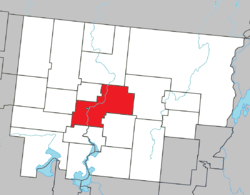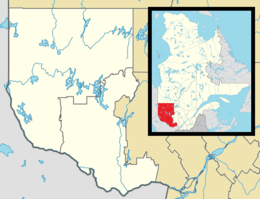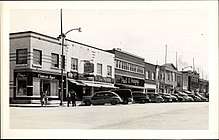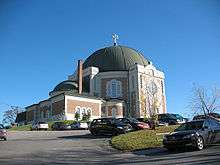Amos, Quebec
Amos is a town in northwestern Quebec, Canada, on the Harricana River. It is the seat of Abitibi Regional County Municipality.
Amos | |
|---|---|
Town | |
Skyline of Amos and the Harricana River | |
.svg.png) Coat of arms | |
 Location within Abitibi RCM. | |
 Amos Location in western Quebec. | |
| Coordinates: 48°34′N 78°07′W[1] | |
| Country | Canada |
| Province | Quebec |
| Region | Abitibi-Témiscamingue |
| RCM | Abitibi |
| Settled | 1910 |
| Constituted | January 17, 1987 |
| Government | |
| • Mayor | Sébastien D'Astous |
| • Federal riding | Abitibi—Témiscamingue |
| • Prov. riding | Abitibi-Ouest |
| Area | |
| • Town | 435.10 km2 (167.99 sq mi) |
| • Land | 430.67 km2 (166.28 sq mi) |
| • Urban | 7.91 km2 (3.05 sq mi) |
| • Metro | 1,650.99 km2 (637.45 sq mi) |
| Elevation | 310.00 m (1,017.06 ft) |
| Population (2016)[4] | |
| • Town | 12,823 |
| • Density | 29.8/km2 (77/sq mi) |
| • Urban | 9,400 |
| • Urban density | 1,188.8/km2 (3,079/sq mi) |
| • Metro | 17,090 |
| • Metro density | 10.4/km2 (27/sq mi) |
| • Pop 2011-2016 | |
| • Dwellings | 5,910 |
| Time zone | UTC−5 (EST) |
| • Summer (DST) | UTC−4 (EDT) |
| Postal code(s) | J9T |
| Area code(s) | 819 |
| Highways | |
| Website | www |
Amos is the main town on the Harricana River, and the smallest of the three primary towns — after Rouyn-Noranda and Val-d'Or — in the Abitibi-Témiscamingue region of Quebec. Its main resources are spring water, gold and wood products, including paper. In 2012, Quebec Lithium Corp. re-opened Canada's first lithium mine, which had operated as an underground mine from 1955–65. They are planning to carve an open pit mine over pegmatite dikes. (The pegmatite is about 1% lithium carbonate.) The mine is about 60 kilometres (37 mi) north of Val-d'Or, 38 kilometres (24 mi) southeast of Amos, and 15 kilometres (9.3 mi) km west of Barraute. It is in the northeast corner of La Corne Township. Access to the mine is via paved road from Val d'Or.[8]
The smaller communities of Lac-Gauvin and Saint-Maurice-de-Dalquier are also within the municipal boundaries of Amos.
History
Rupert's Land, in which Abitibi was located, was owned by the Hudson's Bay Company and was bought by Canada in 1869. Abitibi itself was then annexed to the province in Quebec on June 13, 1898, by an act of the federal Parliament.
Amos was the first colonisation point for the region of Abitibi, with colonization beginning in 1910. The municipality was established in 1914 while the city itself was chartered in 1925. The name of the city came from the maiden name of the wife of Sir Lomer Gouin, then premier of Quebec.
A related municipality was created in 1917 under the name 'Municipalité de la partie ouest des cantons unis de Figuery et Dalquier' (Municipality of the western part of the united townships of Figuery and Dalquier) which changed its name to Amos-Ouest in 1949. In 1974 the municipality fused with the city of Amos proper. Another related municipality was created in 1918 under the name 'Municipalité de la partie est des cantons Figuery et Dalquier' (Municipality of the eastern part of the united townships of Figuery and Dalquier), which also changed its name later 1950 to Amos-Est. The municipality was finally integrated into the city of Amos itself in 1987.
Government
The current mayor of the city is Sébastien D'Astous, who took office on February 20, 2015, after winning a by-election[9] following the death in office of former mayor Ulrick Chérubin in September 2014. In the by-election D'Astous, formerly a city councillor, defeated Donald Blanchet, who had served as interim mayor between Chérubin's death and the by-election.
In the National Assembly of Quebec, Amos is within the electoral district of Abitibi-Ouest, represented by Coalition Avenir Québec MNA Suzanne Blais. In the House of Commons of Canada, the city is in the Abitibi—Témiscamingue district, represented by NDP MP Christine Moore.
Amos is the seat of the judicial district of Abitibi.[10]
Mayors
- Hector Authier, 1914-1918
- David Gourd, 1918-1921[11]
- Joseph Grenier, 1921-1923
- J.O. Germain, 1923-1928
- T.A. Lalonde, 1928-1929
- J.É. Montambault, 1929-1931
- Julien Beaudry, 1931-1934
- G.A. Brunet, 1934-1939
- Fridolin Simard, 1939-1943
- G.A. Brunet, 1943-1947
- Fridolin Simard, 1947-1957
- G.A. Brunet, 1957-1965
- Gérard Magny, 1965-1971
- Jean-Hugues Boutin, 1971-1974
- Laurier St-Laurent, 1974-1982
- Marcel Lesyk, 1982-1987
- Jean-Paul Veilleux, 1987-1990
- André Brunet, 1990-1998
- Murielle Angers-Turpin, 1998-2002
- Ulrick Chérubin, 2002-2014[12]
- Donald Blanchet, 2014-2015
- Sébastien D'Astous, 2015–present
Media

Demographics
The town's urban area had a population of 9,400 in the Canada 2011 Census. Its census agglomeration, which consists of Amos itself, the municipalities of Saint-Dominique-du-Rosaire, Saint-Félix-de-Dalquier, Saint-Mathieu-d'Harricana, Sainte-Gertrude-Manneville, the township municipality of Trécesson and the First Nations reserve of Pikogan, had a population of 17,090.
In the Canada 2006 Census, the census agglomeration had been defined differently: it did not include Saint-Félix-de-Dalquier but did include Landrienne and Saint-Marc-de-Figuery.[13]
| Year | Pop. | ±% |
|---|---|---|
| 1956 | 5,145 | — |
| 1991 | 13,783 | +167.9% |
| 1996 | 13,632 | −1.1% |
| 2001 | 13,044 | −4.3% |
| 2006 | 12,584 | −3.5% |
| 2011 | 12,671 | +0.7% |
| 2016 | 12,823 | +1.2% |
| [14] | ||
Climate
Amos has a humid continental climate (Köppen climate classification Dfb), just above a subarctic climate, with warm summers, very cold winters and heavy precipitation for most of the year.
| Climate data for Amos | |||||||||||||
|---|---|---|---|---|---|---|---|---|---|---|---|---|---|
| Month | Jan | Feb | Mar | Apr | May | Jun | Jul | Aug | Sep | Oct | Nov | Dec | Year |
| Record high °C (°F) | 8.3 (46.9) |
11.0 (51.8) |
21.7 (71.1) |
29.0 (84.2) |
32.2 (90.0) |
37.2 (99.0) |
37.2 (99.0) |
35.6 (96.1) |
32.8 (91.0) |
26.7 (80.1) |
20.0 (68.0) |
14.5 (58.1) |
37.2 (99.0) |
| Average high °C (°F) | −11.7 (10.9) |
−9.0 (15.8) |
−2.2 (28.0) |
6.4 (43.5) |
15.6 (60.1) |
21.0 (69.8) |
23.1 (73.6) |
21.3 (70.3) |
15.4 (59.7) |
8.0 (46.4) |
−0.6 (30.9) |
−8.5 (16.7) |
6.6 (43.9) |
| Daily mean °C (°F) | −17.3 (0.9) |
−15.2 (4.6) |
−8.2 (17.2) |
0.9 (33.6) |
9.3 (48.7) |
14.7 (58.5) |
17.2 (63.0) |
15.6 (60.1) |
10.5 (50.9) |
4.1 (39.4) |
−4.0 (24.8) |
−13.2 (8.2) |
1.2 (34.2) |
| Average low °C (°F) | −22.8 (−9.0) |
−21.3 (−6.3) |
−14.1 (6.6) |
−4.6 (23.7) |
3.0 (37.4) |
8.3 (46.9) |
11.2 (52.2) |
9.9 (49.8) |
5.5 (41.9) |
0.2 (32.4) |
−7.4 (18.7) |
−18 (0) |
−4.2 (24.4) |
| Record low °C (°F) | −48.9 (−56.0) |
−52.8 (−63.0) |
−42.2 (−44.0) |
−29.4 (−20.9) |
−16.7 (1.9) |
−5.6 (21.9) |
−3.9 (25.0) |
−1.7 (28.9) |
−7.2 (19.0) |
−14.4 (6.1) |
−33.3 (−27.9) |
−47.8 (−54.0) |
−52.8 (−63.0) |
| Average precipitation mm (inches) | 55.1 (2.17) |
35.1 (1.38) |
52.7 (2.07) |
62.6 (2.46) |
79.0 (3.11) |
96.9 (3.81) |
112.8 (4.44) |
99.8 (3.93) |
110.7 (4.36) |
84.4 (3.32) |
71.5 (2.81) |
57.9 (2.28) |
918.4 (36.16) |
| Average rainfall mm (inches) | 4.8 (0.19) |
2.2 (0.09) |
14.3 (0.56) |
39.9 (1.57) |
77.7 (3.06) |
96.9 (3.81) |
112.8 (4.44) |
99.8 (3.93) |
110.2 (4.34) |
75.3 (2.96) |
29.6 (1.17) |
7.3 (0.29) |
670.7 (26.41) |
| Average snowfall cm (inches) | 50.6 (19.9) |
33.0 (13.0) |
38.2 (15.0) |
22.8 (9.0) |
1.3 (0.5) |
0.1 (0.0) |
0 (0) |
0 (0) |
0.4 (0.2) |
9.1 (3.6) |
41.8 (16.5) |
51.0 (20.1) |
248.4 (97.8) |
| Average precipitation days (≥ 0.2 mm) | 11.6 | 8.1 | 9.4 | 10.2 | 12.2 | 14.1 | 14.9 | 14.0 | 16.7 | 15.3 | 13.3 | 12.5 | 152.3 |
| Average rainy days (≥ 0.2 mm) | 0.82 | 0.75 | 3.2 | 6.9 | 12.0 | 14.1 | 14.9 | 14.0 | 16.6 | 13.9 | 5.3 | 1.4 | 103.7 |
| Average snowy days (≥ 0.2 cm) | 11.0 | 7.8 | 6.9 | 4.2 | 0.45 | 0.03 | 0 | 0 | 0.14 | 2.6 | 9.4 | 11.5 | 54.0 |
| Mean monthly sunshine hours | 81.3 | 121.4 | 152.1 | 173.3 | 212.8 | 235.3 | 249.4 | 215.6 | 131.5 | 83.7 | 52.9 | 59.8 | 1,769 |
| Source: Environment Canada[7] | |||||||||||||
References
- Reference number 1229 of the Commission de toponymie du Québec (in French)
- "Amos". Répertoire des municipalités (in French). Ministère des Affaires municipales, des Régions et de l'Occupation du territoire. Archived from the original on 2012-01-12. Retrieved 2011-01-14.
- Parliament of Canada Federal Riding History: ABITIBI--TÉMISCAMINGUE (Quebec)
- "Census Profile, 2016 Census Amos, Ville [Census subdivision], Quebec and Abitibi, Municipalité régionale de comté [Census division], Quebec". www12.statcan.gc.ca. Government of Canada. February 8, 2017. Archived from the original on January 10, 2020. Retrieved January 10, 2020.
- "Amos (Population centre) census profile". 2011 Census data. Statistics Canada. Retrieved 2012-05-24.
- "Amos (Census agglomeration) census profile". 2011 Census data. Statistics Canada. Retrieved 2012-05-24. The census agglomeration consists of Amos, Pikogan, Saint-Dominique-du-Rosaire, Saint-Félix-de-Dalquier, Saint-Mathieu-d'Harricana, Sainte-Gertrude-Manneville, Trécesson. In the 2006 census, the census agglomeration had not included Saint-Félix-de-Dalquier, but had included Landrienne and Saint-Marc-de-Figuery.
- Environment Canada, Canadian Climate Normals 1971-2000. Retrieved March 31, 2012.
- "Quebec Lithium". Canada Lithium Corp. Archived from the original on 2013-03-10. Retrieved 2013-03-07.
- "D'Astous gagne le cœur des Amossois" Archived 2015-02-16 at the Wayback Machine. L'Écho Abitibien, February 15, 2015.
- Territorial Division Act. Revised Statutes of Quebec D-11.
- "David Gourd, M.P., Long Leader in Amos and Abitibi District". Val-d'Or Star, July 8, 1949.
- "Le maire d'Amos, Ulrick Chérubin, est mort". Radio-Canada. 25 September 2014. Retrieved 25 September 2014.
- "Amos (Census agglomeration) community profile". 2006 Census data. Statistics Canada. Retrieved 2012-05-24.
- https://archive.org/details/195692501935011958engfra/page/n23/mode/2up
